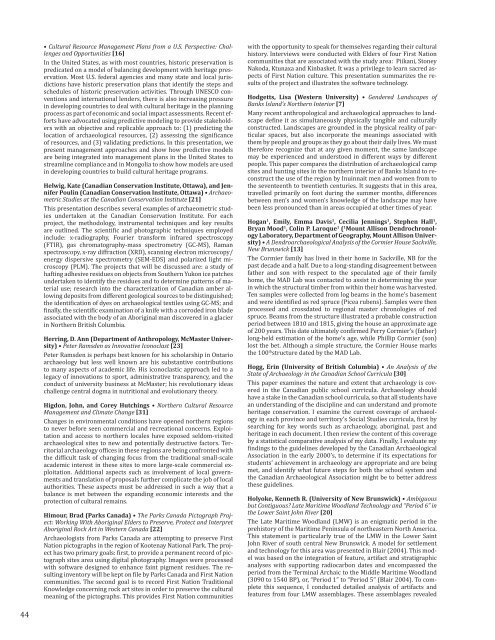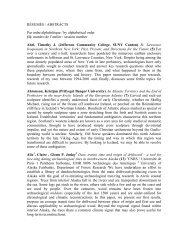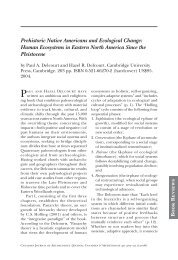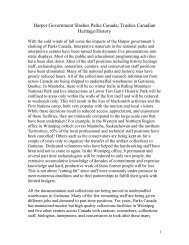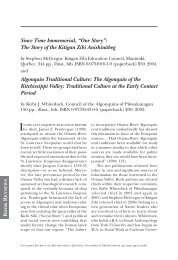16 - 20 MAI MAY 16 - 20 - Canadian Archaeological Association
16 - 20 MAI MAY 16 - 20 - Canadian Archaeological Association
16 - 20 MAI MAY 16 - 20 - Canadian Archaeological Association
Create successful ePaper yourself
Turn your PDF publications into a flip-book with our unique Google optimized e-Paper software.
• Cultural Resource Management Plans from a U.S. Perspective: Challenges<br />
and Opportunities [<strong>16</strong>]<br />
In the United States, as with most countries, historic preservation is<br />
predicated on a model of balancing development with heritage preservation.<br />
Most U.S. federal agencies and many state and local jurisdictions<br />
have historic preservation plans that identify the steps and<br />
schedules of historic preservation activities. Through UNESCO conventions<br />
and international lenders, there is also increasing pressure<br />
in developing countries to deal with cultural heritage in the planning<br />
process as part of economic and social impact assessments. Recent efforts<br />
have advocated using predictive modeling to provide stakeholders<br />
with an objective and replicable approach to: (1) predicting the<br />
location of archaeological resources, (2) assessing the significance<br />
of resources, and (3) validating predictions. In this presentation, we<br />
present management approaches and show how predictive models<br />
are being integrated into management plans in the United States to<br />
streamline compliance and in Mongolia to show how models are used<br />
in developing countries to build cultural heritage programs.<br />
Helwig, Kate (<strong>Canadian</strong> Conservation Institute, Ottawa), and Jennifer<br />
Poulin (<strong>Canadian</strong> Conservation Institute, Ottawa) • Archaeometric<br />
Studies at the <strong>Canadian</strong> Conservation Institute [21]<br />
This presentation describes several examples of archaeometric studies<br />
undertaken at the <strong>Canadian</strong> Conservation Institute. For each<br />
project, the methodology, instrumental techniques and key results<br />
are outlined. The scientific and photographic techniques employed<br />
include: x-radiography, Fourier transform infrared spectroscopy<br />
(FTIR), gas chromatography-mass spectrometry (GC-MS), Raman<br />
spectroscopy, x-ray diffraction (XRD), scanning electron microscopy/<br />
energy dispersive spectrometry (SEM-EDS) and polarized light microscopy<br />
(PLM). The projects that will be discussed are: a study of<br />
hafting adhesive residues on objects from Southern Yukon ice patches<br />
undertaken to identify the residues and to determine patterns of material<br />
use; research into the characterization of <strong>Canadian</strong> amber allowing<br />
deposits from different geological sources to be distinguished;<br />
the identification of dyes on archaeological textiles using GC-MS; and<br />
finally, the scientific examination of a knife with a corroded iron blade<br />
associated with the body of an Aboriginal man discovered in a glacier<br />
in Northern British Columbia.<br />
Herring, D. Ann (Department of Anthropology, McMaster University)<br />
• Peter Ramsden as Innovative Iconoclast [23]<br />
Peter Ramsden is perhaps best known for his scholarship in Ontario<br />
archaeology but less well known are his substantive contributions<br />
to many aspects of academic life. His iconoclastic approach led to a<br />
legacy of innovations to sport, administrative transparency, and the<br />
conduct of university business at McMaster; his revolutionary ideas<br />
challenge central dogma in nutritional and evolutionary theory.<br />
Higdon, John, and Corey Hutchings • Northern Cultural Resource<br />
Management and Climate Change [31]<br />
Changes in environmental conditions have opened northern regions<br />
to never before seen commercial and recreational concerns. Exploitation<br />
and access to northern locales have exposed seldom-visited<br />
archaeological sites to new and potentially destructive factors. Territorial<br />
archaeology offices in these regions are being confronted with<br />
the difficult task of changing focus from the traditional small-scale<br />
academic interest in these sites to more large-scale commercial exploitation.<br />
Additional aspects such as involvement of local governments<br />
and translation of proposals further complicate the job of local<br />
authorities. These aspects must be addressed in such a way that a<br />
balance is met between the expanding economic interests and the<br />
protection of cultural remains.<br />
Himour, Brad (Parks Canada) • The Parks Canada Pictograph Project:<br />
Working With Aboriginal Elders to Preserve, Protect and Interpret<br />
Aboriginal Rock Art in Western Canada [22]<br />
Archaeologists from Parks Canada are attempting to preserve First<br />
Nation pictographs in the region of Kootenay National Park. The project<br />
has two primary goals: first, to provide a permanent record of pictograph<br />
sites area using digital photography. Images were processed<br />
with software designed to enhance faint pigment residues. The resulting<br />
inventory will be kept on file by Parks Canada and First Nation<br />
communities. The second goal is to record First Nation Traditional<br />
Knowledge concerning rock art sites in order to preserve the cultural<br />
meaning of the pictographs. This provides First Nation communities<br />
with the opportunity to speak for themselves regarding their cultural<br />
history. Interviews were conducted with Elders of four First Nation<br />
communities that are associated with the study area: Piikani, Stoney<br />
Nakoda, Ktunaxa and Kinbasket. It was a privilege to learn sacred aspects<br />
of First Nation culture. This presentation summarizes the results<br />
of the project and illustrates the software technology.<br />
Hodgetts, Lisa (Western University) • Gendered Landscapes of<br />
Banks Island’s Northern Interior [7]<br />
Many recent anthropological and archaeological approaches to landscape<br />
define it as simultaneously physically tangible and culturally<br />
constructed. Landscapes are grounded in the physical reality of particular<br />
spaces, but also incorporate the meanings associated with<br />
them by people and groups as they go about their daily lives. We must<br />
therefore recognize that at any given moment, the same landscape<br />
may be experienced and understood in different ways by different<br />
people. This paper compares the distribution of archaeological camp<br />
sites and hunting sites in the northern interior of Banks Island to reconstruct<br />
the use of the region by Inuinnait men and women from to<br />
the seventeenth to twentieth centuries. It suggests that in this area,<br />
travelled primarily on foot during the summer months, differences<br />
between men’s and women’s knowledge of the landscape may have<br />
been less pronounced than in areas occupied at other times of year.<br />
Hogan 1 , Emily, Emma Davis 1 , Cecilia Jennings 1 , Stephen Hall 1 ,<br />
Bryan Mood 1 , Colin P. Laroque 1 ( 1 Mount Allison Dendrochronology<br />
Laboratory, Department of Geography, Mount Allison University)<br />
• A Dendroarchaeological Analysis of the Cormier House Sackville,<br />
New Brunswick [13]<br />
The Cormier family has lived in their home in Sackville, NB for the<br />
past decade and a half. Due to a long-standing disagreement between<br />
father and son with respect to the speculated age of their family<br />
home, the MAD Lab was contacted to assist in determining the year<br />
in which the structural timber from within their home was harvested.<br />
Ten samples were collected from log beams in the home’s basement<br />
and were identified as red spruce (Picea rubens). Samples were then<br />
processed and crossdated to regional master chronologies of red<br />
spruce. Beams from the structure illustrated a probable construction<br />
period between 1810 and 1815, giving the house an approximate age<br />
of <strong>20</strong>0 years. This date ultimately confirmed Perry Cormier’s (father)<br />
long-held estimation of the home’s age, while Phillip Cormier (son)<br />
lost the bet. Although a simple structure, the Cormier House marks<br />
the 100 th structure dated by the MAD Lab.<br />
Hogg, Erin (University of British Columbia) • An Analysis of the<br />
State of Archaeology in the <strong>Canadian</strong> School Curricula [30]<br />
This paper examines the nature and extent that archaeology is covered<br />
in the <strong>Canadian</strong> public school curricula. Archaeology should<br />
have a stake in the <strong>Canadian</strong> school curricula, so that all students have<br />
an understanding of the discipline and can understand and promote<br />
heritage conservation. I examine the current coverage of archaeology<br />
in each province and territory’s Social Studies curricula, first by<br />
searching for key words such as archaeology, aboriginal, past and<br />
heritage in each document. I then review the content of this coverage<br />
by a statistical comparative analysis of my data. Finally, I evaluate my<br />
findings to the guidelines developed by the <strong>Canadian</strong> <strong>Archaeological</strong><br />
<strong>Association</strong> in the early <strong>20</strong>00’s, to determine if its expectations for<br />
students’ achievement in archaeology are appropriate and are being<br />
met, and identify what future steps for both the school system and<br />
the <strong>Canadian</strong> <strong>Archaeological</strong> <strong>Association</strong> might be to better address<br />
these guidelines.<br />
Holyoke, Kenneth R. (University of New Brunswick) • Ambiguous<br />
but Contiguous? Late Maritime Woodland Technology and “Period 6” in<br />
the Lower Saint John River [<strong>20</strong>]<br />
The Late Maritime Woodland (LMW) is an enigmatic period in the<br />
prehistory of the Maritime Peninsula of northeastern North America.<br />
This statement is particularly true of the LMW in the Lower Saint<br />
John River of south central New Brunswick. A model for settlement<br />
and technology for this area was presented in Blair (<strong>20</strong>04). This model<br />
was based on the integration of feature, artifact and stratigraphic<br />
analyses with supporting radiocarbon dates and encompassed the<br />
period from the Terminal Archaic to the Middle Maritime Woodland<br />
(3090 to 1540 BP), or, “Period 1” to “Period 5” (Blair <strong>20</strong>04). To complete<br />
this sequence, I conducted detailed analysis of artifacts and<br />
features from four LMW assemblages. These assemblages revealed<br />
44


